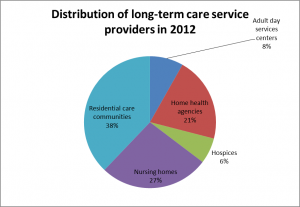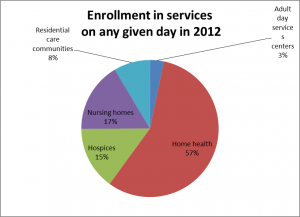And a question: What more would you like to know?
In 2012, the CDC and the National Center for Health administered the first wave of the National Study of Long-Term Care Providers. The data include information on supply, organization, staffing, and services provided in adult day services centers, hospice, nursing homes, and residential care communities as well as demographics, health, and functional limitations of users. Most of the numbers in this post come from the 2013 report of this data.
What is long-term care?
Long-term care covers a broad range of services. It can be health care, personal care (such as help with bathing or dressing), and supportive services (such as counseling or case management). These services can be provided in the home, in the community, or in a residential setting and they can include paid services as well as unpaid care from family or friends. Most long-term care services are used by adults aged 65 and over.
Over two-thirds of us who reach age 65 will probably need some kind of long-term care services during our lifetime.
 In 2012, about 58,500 paid and regulated long-term care services providers served about 8 million people in the United States. The majority of providers were residential care communities (such as assisted living), nursing homes, or home health agencies. The vast majority of these are located in metropolitan areas and most long-term care providers in the U.S. are for-profit.
In 2012, about 58,500 paid and regulated long-term care services providers served about 8 million people in the United States. The majority of providers were residential care communities (such as assisted living), nursing homes, or home health agencies. The vast majority of these are located in metropolitan areas and most long-term care providers in the U.S. are for-profit.
Long-term care providers employ registered nurses, licensed practical or vocational nurses, aides (ranging from certified nursing assistants and home health aides to medication technicians), and social workers.
Most hospices employed at least one social worker. Three-quarters of nursing homes employed a social worker and just under half of adult day services centers and home health agencies had social workers on staff. Only 14% of residential care communities employed a social worker. Social workers, however, spend the least amount of time with clients compared to other professionals. Aides spend the most amount of time.
Most providers do provide social work services, at least by referral if not directly. Other services include mental health or counseling services, therapeutic services, and skilled nursing or other nursing services. Nursing homes and residential care communities have pharmacy services as well as hospice services of their own.
Who uses long-term care?
 On any given day in 2012, the majority of people using long-term care were receiving home health care.
On any given day in 2012, the majority of people using long-term care were receiving home health care.
Most users of long-term care are over 65. Residential care communities, nursing homes, and hospices serve more people who are 85 and older than home health or adult day services centers.
Most users are women and non-Hispanic White. Adult day services centers are the most diverse with 47.3% non-Hispanic White, 20.2% Hispanic, 16.8% non-Hispanic Black, and 15.7% non-Hispanic other.
Just under half of nursing home residents have Alzheimer’s disease or depression. Alzheimer’s was least prevalent in home health (30.1%) and adult day services centers (31.9%). Depression was least prevalent in hospice (22.2%), adult day services centers (23.5%), and residential care communities (24.8%).
The majority of home health patients and residents in nursing homes need help with activities of daily living such as bathing, dressing, toileting, and eating, but adult day service centers and residential care communities have clients who need these services as well.
This is just a snapshot to give you a lay of the land.
Let me know what other things you’d like to know about long-term care.


 I also realize that there are shades of purple in these arguments. But still. I am quite sure there are plenty of us on both sides of the debate who regularly engage in a good face palm in utter amazement that the other side can’t see the plain facts staring them right in the face. (And back we go to that Republican vote thing).
I also realize that there are shades of purple in these arguments. But still. I am quite sure there are plenty of us on both sides of the debate who regularly engage in a good face palm in utter amazement that the other side can’t see the plain facts staring them right in the face. (And back we go to that Republican vote thing).